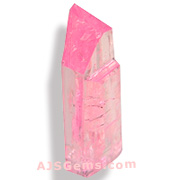To produce a fine cut gemstone, you have to start with high quality rough material. Even the best cutting cannot produce a beautiful gem from mediocre rough. But even moderately good cutting can produce an excellent result from gemmy material.
We buy precious and semi precious rough from mines all over the world, from Africa to North & South America to Asia. We cut our gems here in Bangkok, using some of the most experienced lapidaries in the trade.
 |
| Tsavorite Garnet Rough Stone from East Africa |
Identifying and examining gemstone rough is much more challenging than evaluating cut and polished gems. It takes years of experience to be able to predict the color and clarity of the finished stone by examining the rough. Since it is difficult to see inside the rough stone, dealers have developed techniques to detect inclusions inside the rough material. Backlighting the material with a very strong light will reveal any cracks and indicate the quality of the crystal; and immersing the stone in water will reduce surface reflections and make inclusions more visible.
If evaluating rough stone is not already sufficiently challenging, there are other considerations which are unique to evaluating uncut gems. In addition to color and clarity, the size and shape of the rough stone is very important. Dealers buying faceting rough look for stones that have good depth and symmetry -- chunky or rounded rough is much better than flat or assymetrical shapes, since it will yield larger finished stones.
Size is very important because the the yield from even well-shaped rough material is typically only about 25%. So a 4 carat piece of rough stone may look impressive, but it will usually yield only a 1 carat finished stone.
 |
| Rare Pink Tanzanite Crystal |
For high value gems such as ruby, sapphire, spinel, alexandrite and the rarer garnets, the shape of the rough will usually dictate the shape of the finished gem. Customers often ask us why there are so few round sapphires in the market. The answer is that the rough material, which is usually alluvial in origin, tends to be oval in shape. Cutting a round gem from oval-shaped rough would result in a lower yield and a waste of valuable gem material.
Though our business is mainly the sale of fine cut and polished gems, we do occasionally offer rough gemstones for sale, especially at the annual Tucson gem show. We also offer rare uncut crystals on our website from time to time, and have recently featured ruby, pink tanzanite and jeremejevite crystals.
We also produce gemstone carvings from interesting rough that is not clean enough to be faceted. We have featured carvings from materials such as lapis lazuli, chrysoprase, ruby, ruby-zoisite, fluorite, amethyst and chrysocolla.